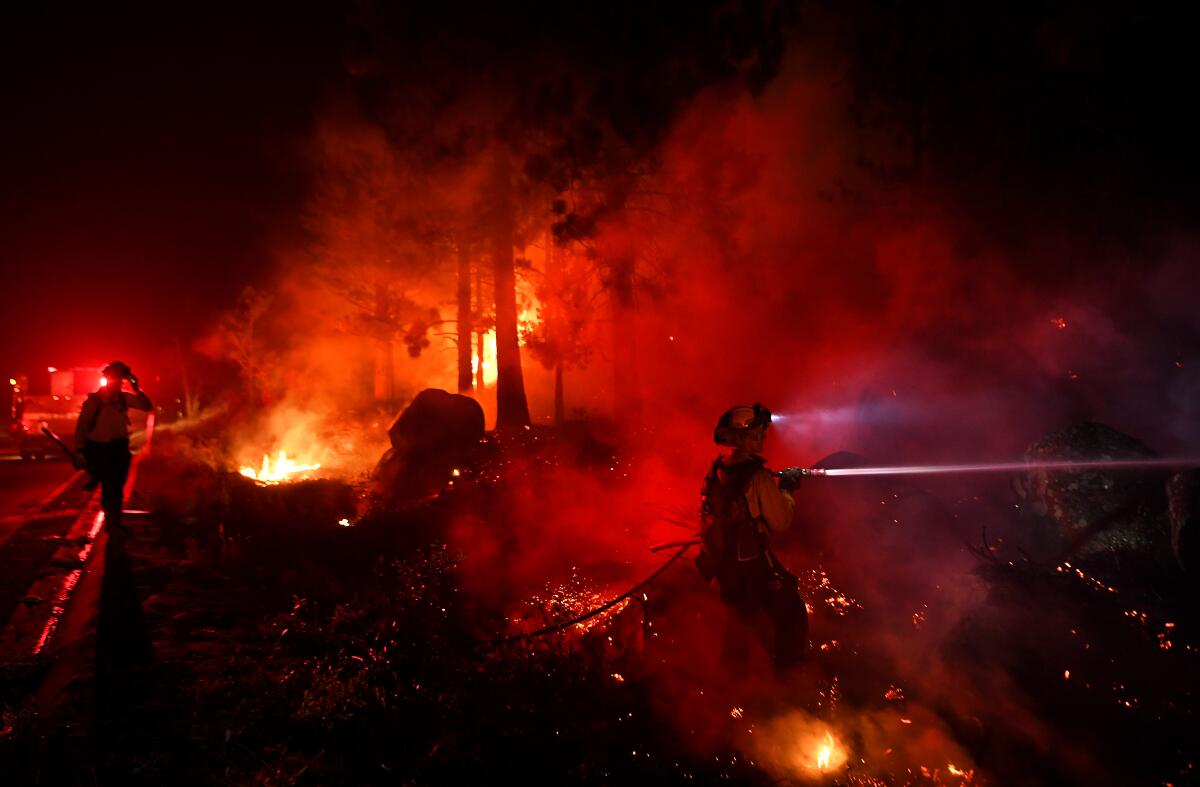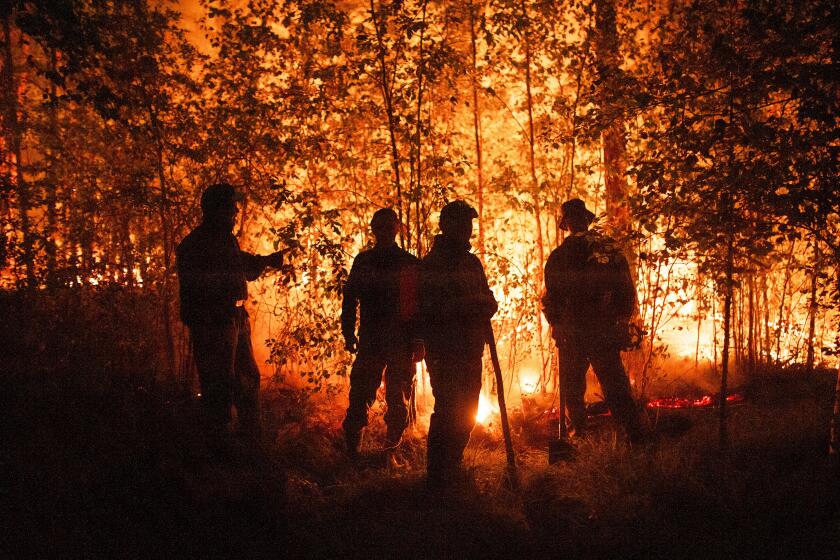Wildfires are getting worse across the globe. How does California compare?

- Share via
An alarming new United Nations report warns that the number of extreme wildfires is expected to increase 50% globally by the end of the century, and that governments are largely unprepared for the burgeoning crisis.
Even the Arctic, previously all but immune to the threat, faces growing wildfire risk because of climate change and other factors, according to the report, which was published Wednesday ahead of the upcoming U.N. Environment Assembly in Nairobi, Kenya.
The findings likely sound all too familiar to California residents, who for years have been living with the reality of hotter, more frequent and more intense wildfires. The five largest blazes recorded in the state have all occurred since 2018, according to the California Department of Forestry and Fire Protection.
Yet the new report shines a light on the hard lessons California is learning — including what it’s getting right and what more needs to be done. In the fire-prone American West and around the world, too much focus remains on response instead of preparation. What’s more, wildfires pose urgent questions about land use and public health that extend far beyond the boundaries of their flames.
“We hear that people in D.C. think of fire as a Western issue, or a Californian issue, but it really isn’t — it’s a global issue,” said Max Moritz, a wildfire specialist with the University of California Cooperative Extension in Santa Barbara who contributed to the report. “It affects all of us.”
A warming planet and land-use changes mean more wildfires will scorch large parts of the globe in coming decades, according to a new U.N. report.
While California wildfires have exploded in recent years, the Golden State isn’t the only place facing increasingly large and more frequent conflagrations. In 2020, brush fires in Australia burned an estimated 84 million acres, killed at least 30 people and reportedly wiped out billions of domesticated and wild animals.
Heat and drought are also priming new terrain for ignition, including rainforests, permafrost and peat swamps, according to the report. In Brazil, wildfires in the last two years seared through almost a third of the world’s largest tropical wetland, the Pantanal, and some fear it may never fully recover.
In response to the rapidly changing conditions, the report outlines three crucial steps for policymakers adapting to a more fiery future: Investing in more planning and prevention; seeking out and sharing knowledge such as Indigenous fire management practices; and elevating wildfire to the “same category of global humanitarian response as major earthquakes and floods.”
“Too often, our response is tardy, costly, and after the fact, with many countries suffering from a chronic lack of investment in planning and prevention,” the report says, noting that most governments typically dedicate more than half of their wildfire spending to response and less than 1% to planning.
In some ways, then, California is already ahead of the curve. Gov. Gavin Newsom last year unveiled a $15-billion climate change package, which included $1.5 billion for wildfire response and forest resilience. This year’s proposed budget adds $1.2 billion, much of it for forest thinning, prescribed burns and other projects intended to reduce fire risks.
But while the numbers reflect a shift toward preparedness, more can be done. The state last year also spent more than $1.1 billion in fire suppression emergency costs, according to Cal Fire.
California’s response is also lacking in clarity, according to a separate report from the state’s Legislative Analyst’s Office, which found that additional wildfire funds are merited “given the worsening pattern of large and severe wildfires in recent years” but that an “absence of a strategic wildfire plan makes it difficult to assess” whether the proposed plans are the best approach.
The new law limits the liability of private landowners and public agencies that use prescribed fires under specified conditions.
Wildfire adaption doesn’t end with budgets and finances, however. Stronger regional and international cooperation, as well as the incorporation of shared best practices, can help elevate the global response, the U.N. report said.
One such tool is prescribed burning, a practice that involves the intentional use of fire to clear away the dried vegetation that accumulates over time. The practice is not new in California: For centuries, many of the state’s Indigenous communities considered prescribed burns essential for forest health and employed it to great success.
But starting about 100 years ago, Indigenous burning practices were suppressed through aggressive firefighting policies, including a now-defunct U.S. Forest Service rule that required all blazes to be extinguished by 10 a.m. the day after they ignited.
Those efforts had disastrous consequences for the state, enabling a surplus of growth to build up and later act as fuel for fires. Last year, Newsom signed two new laws paving the way for more prescribed burning, a move largely celebrated by state experts.
That the U.N. Report also includes cultural and Indigenous fire management practices is a positive step, said Don Hankins, a professor of geography at Cal State Chico who contributed to the report.
“The landscape is constantly telling us these are the things that we need to be paying attention to,” said Hankins, who is also a person of Miwok descent. “We need to get to the point where we’re playing offensive instead of defensive with fire, and that’s where Indigenous fire is at, on the more offensive side of it.”
Hankins noted that the U.N. report included not just Indigenous communities in California but also South America, Australia and other places around the world. And while the climate in California is constantly changing, “the only time that the forest was resilient to these warming- and climate-induced changes around fire was under Indigenous stewardship,” he said.
Wildfires are increasing streamflow throughout the western U.S., raising new threats for public safety and water management, according to researchers.
Forest management is still only one piece of the wildfire adaptation puzzle. According to the report, watersheds can be degraded by wildfires, leading to soil erosion, increased flooding and debris flow, and even contamination of the water supply.
What’s more, wildfire smoke can cause significant respiratory and cardiovascular issues for people who inhale it. In 2020, smoke from California wildfires reached the East Coast and Europe — driving home the global nature of the problem.
“The true cost of wildfires — financial, social, and environmental — extends for days, weeks, and even years after the flames subside,” the report said.
Although many of those effects pose disproportionate threats to low-income communities and countries around the world, the factors are at times amplified in California, where population growth, demand for housing, urban development and land-use practices are pushing more people and homes into the wildland-urban interface.
Smoke from the 2018 Camp fire, which razed the Northern California town of Paradise and killed 85 people, was found to be far more harmful than that of vegetation fires because it spread toxic chemicals as it burned through homes, vehicles and electronic devices, endangering not only residents but also firefighters and first responders.
The wildland-urban interface issue is not unique to California, but it’s also not one that every other wildfire-prone area is dealing with. Massive Siberian wildfires in 2020 were linked to warming Arctic but threatened fewer lives.
“If we don’t start thinking of the solutions in terms of where and how we’re building, I feel like we’re missing something pretty important,” said Moritz, who is also an adjunct professor at UC Santa Barbara.
Many in the state are starting to get the message: Last month, a California judge paused the plans for a luxury development in Lake County citing concerns about wildfire evacuation plans. The move followed similar actions against plans for a housing development in a fire-prone area of San Diego County and a 19,300-home community in the southern flanks of the Tehachapi Mountains.
A court has ruled that Lake County failed to properly analyze how a Guenoc Valley development would affect evacuation routes in times of wildfire.
According to the U.N. report, eliminating the risk of wildfires altogether is not possible, and even under the lowest greenhouse gas emissions scenario, the planet will likely see a significant increase in wildfire events in the years to come. But that doesn’t mean all hope is lost.
“We have to minimize the risk of extreme wildfires by being better prepared: invest more in fire risk reduction, work with local communities, and strengthen global commitment to fight climate change,” United Nations Environment Program chief Inger Andersen said in a statement.
Those who worked on the report said they hoped it would stir necessary and urgent conversations about wildfire in the West and worldwide.
“We’re in that international framework, and governments are coming together to discuss this and recognize it,” said Hankins, of Cal State Chico. “It’s putting it onto a different level.”
More to Read
Sign up for Essential California
The most important California stories and recommendations in your inbox every morning.
You may occasionally receive promotional content from the Los Angeles Times.


















